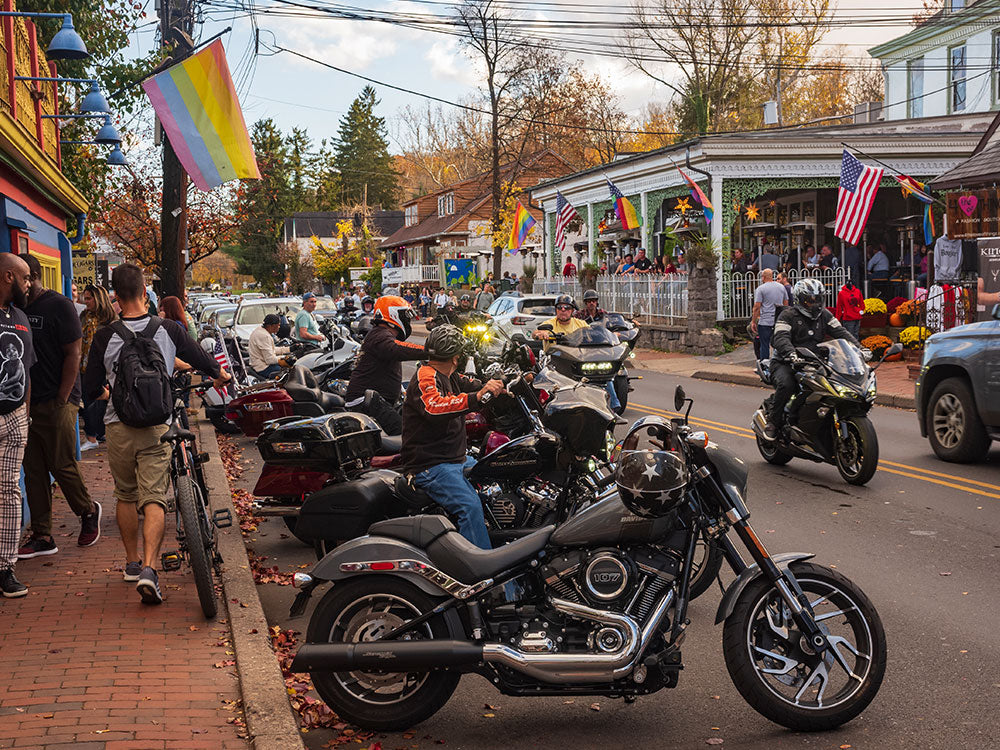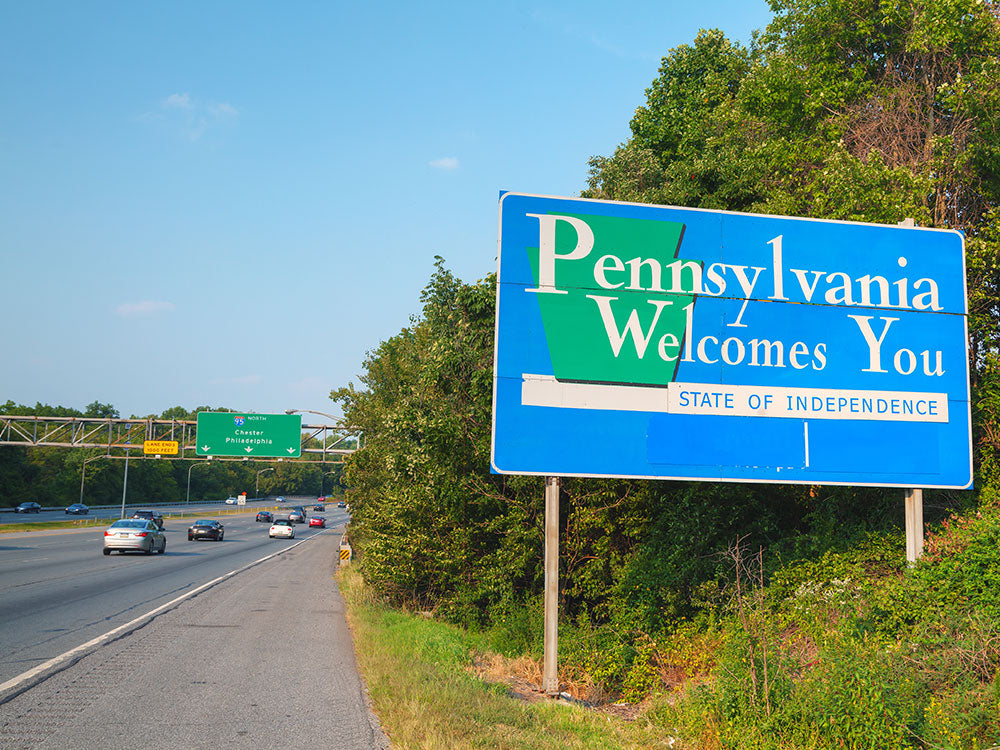Table of Content
1. Introduction
Despite the peaceful and leisurely atmosphere of Pennsylvania’s roads and highways, riders need to maintain some level of vigilance while they navigate. Riding a motorcycle can be more exciting but also a more hazardous experience for the uninitiated. Though motorcycle models are built with certain features to promote better safety for both pedestrians and motorcyclists, it is up to the individual riders to develop their skills behind the handlebars. What better way for riders to do that is by learning about Pennsylvania’s motorcycle laws and licensing procedure.
2. Pennsylvania Motorcycle Insurance

It is required of all motor vehicles owners in Pennsylvania to own vehicle liability insurance coverage that is recognized in this state. It is mandatory to have since hefty fines can be levied against you for property damages and medical expenses if you were involved in an accident. Whenever you are riding your motorcycle, you must carry proof of ownership on your person or secured somewhere on your motorcycle. You must be able to produce the relevant documents when requested by local law enforcement or affected parties following an accident. Failure to produce Pennsylvania motorcycle insurance will result in hefty fines and/or suspension of vehicle registration. In the event your vehicle registration is suspended, you can pay a civil penalty of $500 once in 12 months. Along with the restoration fee and an updated form of insurance, paying the civil penalty fee will allow you to maintain the registration on your motorcycle.
Mandatory Pennsylvania motorcycle insurance requires you to pay a bare minimum for bodily injuries and property damages that may occur during an accident:
$15,000 for bodily injury to a person per accident
$30,000 for bodily injuries to multiple people per accident
$5,000 for property damages sustained per accident
Nonmandatory Pennsylvania motorcycle insurance offers additional coverage that deals with other driver’s insurance plans, payments for medical services, and other causes of damage:
Uninsured coverage
Underinsured coverage
Collision coverage
Comprehensive coverage
Medical expenses
3. Pennsylvania Motorcycle Helmet Laws

In Pennsylvania, motorcyclists and passengers under the age of 21 must wear either a three-quarter or full-face motorcycle helmet since they are produced and regulated by the Snell Memorial Foundation and the U.S. Department of Transportation.
While the age requirement for wearing motorcycle helmets allows some adult riders the option of having to wear a motorcycle helmet only when they choose, this has caused an increase in motorcycle fatalities in recent years:
In 2020, there were a total of 3,308 motorcycle accidents, with only 215 of them being fatal
In 2020, 93.4% of motorcycle crashes resulted in severe or fatal injuries
In 2020, motorcycle accidents made up at least 20.3% of all fatal collisions
In 2020, 42.9% of motorcycle fatalities were wearing protective headgear
Listed in this table below are the features that your motorcycle helmet is required to have if you wish to operate a motorcycle in Pennsylvania:
| Requirements | Three-Quarter Helmet | Full-Face Helmet |
|---|---|---|
| Has the Department of Transportation (DOT) sticker | ✔️ | ✔️ |
| Contours around your head to fit snugly due to comfort padding | ✔️ | ✔️ |
| No signs of damage Ex:// cracks, loose padding, scratches, or frayed straps |
✔️ | ✔️ |
| Has a face shield with no scratches | ❌ | ✔️ |
| Includes separate eye protection with no scratches Ex:// goggles, glasses |
✔️ | ❌ |
| Has a hard and durable outer shell that is shatter-resistant | ✔️ | ✔️ |
| Has an impact-absorbing liner inside the helmet | ✔️ | ✔️ |
| Gives you a clear, peripheral view of your surroundings | ✔️ | ✔️ |
| Securely fastened with neck- or chin-strap | ✔️ | ✔️ |
| Allows airflow without fogging up | ✔️ | ✔️ |
| Can allow you to wear sunglasses underneath | ✔️ | ✔️ |
4. Pennsylvania Motorcycle License Laws

4.1 Pennsylvania Motorcycle Learner’s Permit
A Pennsylvania motorcycle learner’s permit only allows you to legally operate a motorcycle for a year. Before you can get it, you have to pass your 16th birthday and provide at least $10.
To be given the permit, you must fulfill all of the listed criteria:
-
If you are under the age of 18:
Complete the Pennsylvania Motorcycle Safety Basic Rider Course
Have a Certificate of Completion as proof of finishing 65 hours of practice
Present identification documents
Provide proof of Pennsylvania residency
Provide proof of U.S. citizenship
Provide your Social Security Number
Take a photo
Pass the knowledge exam
Pass the vision exam
Pay the required fees
After you have finished earning the permit, you have to begin practicing until you are confident in your expertise as a motorcyclist. However, you are only learning the basics so you do not want to be put into stressful situations. So long as you comply with the following, motorcycle training will fly by quickly:
You are only allowed to operate between sunrise and sunset
You cannot carry any passengers aside from a licensed instructor
You must wear protective gear
4.2 Pennsylvania Motorcycle License
Taking into account the initial motorcycle learner’s permit, plus the license being valid for four years, you will have to provide $45.50 and must be at least 16 years old.
Listed below are the requirements you will need to fulfill to obtain a Pennsylvania motorcycle license:
| Requirements | Applicants Ages Below 18 |
Applicants Ages 18 and Above |
|---|---|---|
| Have a valid Pennsylvania driver’s license | ✔️ | ✔️ |
| Complete a Pennsylvania Motorcycle Safety Program Basic Rider Course | ✔️* | ✔️* |
| Held onto a Pennsylvania motorcycle learner’s permit for at least six months | ✔️ | ✔️ |
| Have a Certificate of Completion as proof of finishing 65 hours of skill-building | ✔️ | ✔️ |
| Provide proof of Pennsylvania motorcycle insurance | ✔️ | ✔️ |
| Provide proof of Pennsylvania vehicle registration | ✔️ | ✔️ |
| Fill out the appropriate driver’s license application | ✔️ | ✔️ |
| Must have the consent of a parent or legal guardian if you are a minor | ✔️ | ❌ |
| Provide your social security number | ✔️ | ✔️ |
| Pay required fees | ✔️ | ✔️ |
| Present valid photo I.D. | ✔️ | ✔️ |
| Take a photo | ✔️ | ✔️ |
| Take the vision exam | ✔️ | ✔️ |
| Pass the knowledge test | ✔️ | ✔️ |
| Pass the road skills test | ✔️* | ✔️* |
| Provide proof of U.S. citizenship | ✔️ | ✔️ |
| Provide proof of residency in Pennsylvania | ✔️ | ✔️ |
*Any applicant that successfully finishes a Pennsylvania Motorcycle Safety Program Basic Rider Course will have the option of having the road skills portion of the Pennsylvania motorcycle license test waived.
4.3 Pennsylvania Motorcycle License Test
Written Portion:
Complete 25 multiple-choice questions
Questions will be based on content from the Pennsylvania Motorcycle Operator Manual
Will be tested on an understanding of road rules and safe riding practices
Requires a passing grade of 80% or higher
Riding Skills Portion:
Will be conducted in a controlled, off-street area or an actual traffic environment
Your motorcycle will be subjected to a pre-ride inspection to ensure it meets safety standards
Demonstrate a basic understanding of motorcycle operation
You will be tested on your ability to stay within the speed limit, adjusting speed and position, maintaining visibility, operating under stress, accelerating, braking, turning, stopping, and swerving
The examiner will grade you based on how well you ride at safe speeds, stay within the lanes, and demonstrate riding maneuvers
5. Pennsylvania Motorcycle Passenger Laws
In Pennsylvania, passengers can be of any age since no road laws refer to an obvious age restriction.
The back part of a large driver’s seat
Towards the rear as a separate saddle
Fixed to the side as a sidecar
While there are no limitations on age, that does not automatically make it okay for individuals who are too short to sit in the passenger seat. A passenger who is not secure is likely to get injured if you accelerate or turn suddenly. Therefore, your passenger likely to ride safely behind you:
Must be able to reach the footrests
Must wear an approved motorcycle helmet
Cannot be carrying any packages
Must be able to understand and follow your directions
6. Pennsylvania Lane Splitting Laws

It is illegal for motorcyclists to engage in lane splitting throughout Pennsylvania. If you are unfamiliar with the term, lane splitting refers to riding on top of the boundaries between traffic lanes. These can be considered aspects of lane splitting:
Riding on top of the dividing lines between lanes
Riding in between adjacent rows of stopped vehicles
Overtaking a larger vehicle ahead in the same lane
It is legal for riders to attempt lane sharing in Pennsylvania. Lane sharing is when you travel beside another vehicle by making use of unoccupied space within the same lane. These can be considered aspects of lane sharing:
You are allowed to make full use of the space within your current lane
-
You can only share a lane with another motorcycle if:
Both parties stay apart at least two abreast
Both parties consent beforehand
7. Pennsylvania Motorcycle Equipment Requirements

Many riders do not inspect the state of their motorcycle before they commute or go on a lengthy trip. Despite such negligence, they are still surprised if their motorcycle starts to experience mechanical issues if it has been a long time since their last maintenance check. To save time and reduce inconvenience, you should take the time to fix up any older yet integral pieces your motorcycle needs to function:
Horn
Wheels
Tires
Handlebars
Front & Rear Brakes
Controls
Headlight
Tail Light
Brake Light
Turn Signals
Exhaust System
Muffler
Rearview Mirrors
8. Sources
- Pennsylvania Motorcycle Operator Manual
- Pennsylvania Insurance Department - Motorcycle Insurance
- Pennsylvania Department of Transportation Driver & Vehicle Services - Insurance Overview
- Pennsylvania Department of Transportation Driver & Vehicle Services - Pennsylvania’s Motorcycle Helmet Law Frequently Asked Questions
- Pennsylvania Department of Transportation Driver & Vehicle Services - Motorcycle Permit Process Frequently Asked Questions
- Pennsylvania Department of Transportation Driver & Vehicle Services - Motorcycle License
- Pennsylvania Department of Transportation Driver & Vehicle Services - Motorcycle Safety
- Pennsylvania Department of Transportation Driver & Vehicle Services - Payments and Fees












Leave a comment
All comments are moderated before being published.
This site is protected by hCaptcha and the hCaptcha Privacy Policy and Terms of Service apply.